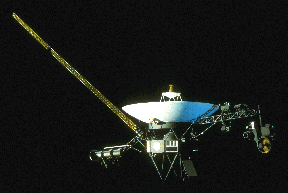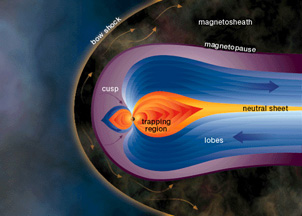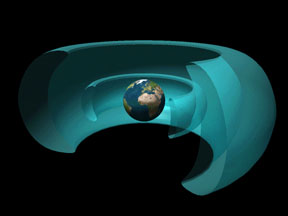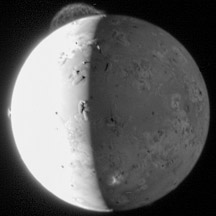Click on image for full size
Image courtesy of NASA/Johns Hopkins University Applied Physics Laboratory/Southwest Research Institute.
The Poles of Io
Io is a large moon of Jupiter. Jupiter has four large moons. Io is the closest of the four to Jupiter. Io has hundreds of volcanoes. It has more active volcanoes than any place else in our Solar System. Some of those volcanoes are near Io's poles.
A volcano named Tvashtar is near Io's North Pole. Two different spacecraft have "seen" Tvashtar erupting. The Galileo spacecraft spotted a huge lava lake in the volcano's crater. It also took pictures of an eruption of a huge lava "curtain" that was 25 km (16 miles) long and at least a kilometer (three thousand feet) high! The New Horizons spacecraft took pictures of an eruption from Tvashtar in 2007.
Another volcano, named Dazhbog, is also fairly close to Io's North Pole. The Voyager spacecraft and the Hubble Space Telescope have taken pictures of Dazhbog. Dazhbog is named after a god from Slavic mythology. Tvashtar is named after the Hindu god of blacksmiths.
Io has a very thin atmosphere. It is mostly sulfur dioxide gas from the volcanoes. Jupiter has a huge magnetic field with lots of radiation trapped in it. Some of that radiation hits Io's atmosphere. It makes gases in the atmosphere glow. That glow is called the aurora, like our Northern Lights or Southern Lights on Earth. The aurora on Io is strange. It is at Io's equator, NOT at its poles!
You might also be interested in:

The Galilean satellites are the 4 major moons of Jupiter, Io, Europa, Ganymede, and Callisto. In this picture, Io, and Io’s surface, are shown on the left-most end, then Europa, and its surface, then Ganymede,
...more
The Galileo spacecraft was launched on October 19, 1989. Galileo had two parts: an orbiter and a descent probe that parachuted into Jupiter's atmosphere. Galileo's main mission was to explore Jupiter and
...more
The rare arrangement of planets Jupiter, Saturn, Uranus, and Neptune in the 1980's made it possible for the Voyager spacecrafts to visit them over a 12 year span instead of the normal 30. They used gravity
...more
The Hubble Space Telescope (HST) was one of the most important exploration tools of the past two decades, and will continue to serve as a great resource well into the new millennium. The HST found numerous
...more
Jupiter's magnetosphere is very special. It is the biggest thing in the entire solar system. Not only is it big enough to hold all of Jupiter's moons, but the sun itself could fit inside. It goes all
...more
One main type of radiation, particle radiation, is the result of subatomic particles hurtling at tremendous speeds. Protons, cosmic rays, and alpha and beta particles are some of the most common types
...more
Amalthea was discovered by E Barnard in 1872. Of the 17 moons it is the 3rd closest to Jupiter, with a standoff distance of 181,300 km. Amalthea is about the size of a county or small state, and is just
...more















